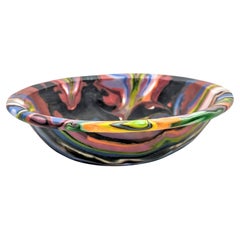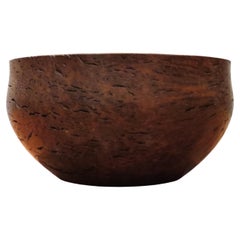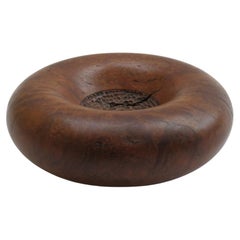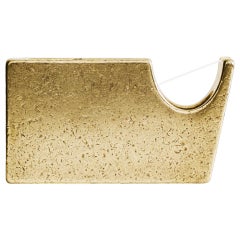Australian Bowls and Baskets
34
5
to
4
4
39
25
33
21
5
34
4
1
Height
to
Width
to
28
15
13
13
10
2,836
11,180
3,982
2,116
2,038
21
13
1
Place of Origin: Australian
A well refined studio glass fusing bowl by Klaus Moje, made in Canberra in 1988
By Klaus Moje
Located in Aachen, DE
A lovely kiln-formed and wheel cut mosaic glass bowl from Klaus Moje's time in Canberra. Cf.: Dan Klein, "Artists in Glass - Late twentieth Century Masters...
Category
1980s Other Vintage Australian Bowls and Baskets
Materials
Glass, Art Glass, Cut Glass
Large Hand Turned Jarrah Wood Decorative Bowl 1980s
Located in Stow on the Wold, GB
Very nicely hand turned bespoke wooden bowl, made from Jarrah Wood originating from Australia. Turned by hand, the bowl has a wonderful thick rim to it, giving a very nice chunky ap...
Category
Late 20th Century Australian Bowls and Baskets
Materials
Wood
Australian Handcrafted Burr Wood Bowl Mallee Wood
Located in Stow on the Wold, GB
Wonderful hand produced bowl, made from solid Mallee wood. Originates from Australia. Very nice smooth finished bowl, contrasting to the textured exterior. Signed Bailey to the under...
Category
Late 20th Century Australian Bowls and Baskets
Materials
Wood
1990s Hand Crafted Australian Wooden Bowl by Terry Baker Bimble Box Wood
Located in Stow on the Wold, GB
Wonderful hand turned wooden bowl produced by Terry Baker. Made from Bimble Box, from the Eucalyptus group. Originates from Australia and dates from the 1990s.
Beautifully shaped, w...
Category
Late 20th Century Australian Bowls and Baskets
Materials
Wood
Brass Tape Dispenser by Henry Wilson
By Henry Wilson
Located in Geneve, CH
Brass Tape Dispenser by Henry Wilson
Dimensions: W 14 x D 5 x H 7 cm
Materials: Brass
The brass tape dispenser is a hefty piece of stationery. I...
Category
2010s Modern Australian Bowls and Baskets
Materials
Brass
Vide Poche Rond by Henry Wilson
By Henry Wilson
Located in Geneve, CH
Vide Poche Rond by Henry Wilson
Dimensions: D 13 x H 4 cm
Materials: Bronze
Discard your day at the door.
Your Vide Poche is designed with your loose-pocket items in mind – think ...
Category
2010s Modern Australian Bowls and Baskets
Materials
Bronze
Aluminum Stack Trays by Henry Wilson
By Henry Wilson
Located in Geneve, CH
Aluminum Stack Trays by Henry Wilson
Dimensions: W 25 x D 5 x H 10 cm
Materials: Aluminum
The stack trays are sold in a set of three that can be used...
Category
2010s Modern Australian Bowls and Baskets
Materials
Aluminum
Bronze Stack Trays by Henry Wilson
By Henry Wilson
Located in Geneve, CH
Bronze Stack Trays by Henry Wilson
Dimesions: W 25 x D 5 x H 10 cm
Materials: Bronze
The stack trays are sold in a set of three that can be used toget...
Category
2010s Post-Modern Australian Bowls and Baskets
Materials
Bronze
Bronze Vide Poche Rond by Henry Wilson
By Henry Wilson
Located in Geneve, CH
Bronze Vide Poche Rond by Henry Wilson
Dimensions: D 13 x H 4 cm
Materials: Bronze
Discard your day at the door.
Your Vide Poche is designed with your loose-pocket items in mind – ...
Category
2010s Modern Australian Bowls and Baskets
Materials
Bronze
Bronze Stack Trays by Henry Wilson
By Henry Wilson
Located in Geneve, CH
Bronze Stack Trays by Henry Wilson
Dimensions: W 25 x D 5 x H 10 cm
Materials: Bronze
The stack trays are sold in a set of three that can be used tog...
Category
2010s Modern Australian Bowls and Baskets
Materials
Bronze
Aboriginal Dot Pattern Gilded Studio Ceramic Bowl, Signed, Australia, 20th C.
Located in Chatham, ON
Aboriginal 'dot' pattern studio pottery bowl with gilded highlights - wheel thrown conical shape - hand painted design with mirror black glaze to the outer sides and background - sig...
Category
20th Century Modern Australian Bowls and Baskets
Materials
Ceramic
Bronze Vide Poche Square by Henry Wilson
By Henry Wilson
Located in Geneve, CH
Bronze Vide Poche Square by Henry Wilson
Dimensions: W 18 x D 18 x H 4 cm
Materials: Bronze
The Vide Poche is designed with your loose-pocket items in mind, think keys, change and p...
Category
2010s Modern Australian Bowls and Baskets
Materials
Bronze
Aluminium Vide Poche Square by Henry Wilson
By Henry Wilson
Located in Geneve, CH
Aluminium Vide Poche Square by Henry Wilson
Dimensions: W 18 x D 18 x H 4 cm
Materials: Aluminium
Discard your day at the door.
Your Vide Poche is designed with your loose-pocket i...
Category
2010s Modern Australian Bowls and Baskets
Materials
Aluminum
Bronze Vide Poche Rond XL by Henry Wilson
By Henry Wilson
Located in Geneve, CH
Bronze Vide Poche Rond XL by Henry Wilson
Dimensions: D 18 x H 4 cm
Materials: Bronze
Your Vide Poche is designed with your loose-pocket items in mind – think keys, change and phon...
Category
2010s Modern Australian Bowls and Baskets
Materials
Bronze
Aluminum Vide Poche Rond by Henry Wilson
By Henry Wilson
Located in Geneve, CH
Aluminum Vide Poche Rond by Henry Wilson
Dimensions: D 13 x H 4 cm
Materials: Aluminum
Discard your day at the door.
Your Vide Poche is designed with your loose-pocket items in mi...
Category
2010s Modern Australian Bowls and Baskets
Materials
Aluminum
Black Travertine Block Big Poche Rond by Henry Wilson
By Henry Wilson
Located in Geneve, CH
Black Travertine Block Big Poche Rond by Henry Wilson
Dimensions. W 35 x D 35 x H 7 cm
Materials: Black Travertine
This sculptural item is handmade i...
Category
2010s Modern Australian Bowls and Baskets
Materials
Travertine
Guatemala Thoronet Dish by Henry Wilson
By Henry Wilson
Located in Geneve, CH
Guatemala Thoronet Dish by Henry Wilson
Dimensions: W 20 x D 30 x H 5 cm
Materials: Guatemala Marble
This sculptural item is handmade in Sydney Australia.
Thoronet dish, shares its...
Category
2010s Modern Australian Bowls and Baskets
Materials
Marble
Aluminum Vide Poche Rond XL by Henry Wilson
By Henry Wilson
Located in Geneve, CH
Aluminum Vide Poche Rond XL by Henry Wilson
Dimensions: D 18 x 4 cm
Materials: Aluminum
Your Vide Poche is designed with your loose-pocket items in mind – think keys, change and ph...
Category
2010s Modern Australian Bowls and Baskets
Materials
Bronze
Polished Aluminium Thoronet Dish by Henry Wilson
By Henry Wilson
Located in Geneve, CH
Polished Aluminium Thoronet Dish by Henry Wilson
Dimensions: W 20 x D 5 x H 30 cm
Materials: Aluminium
Thoronet dish, shares its' name and arched lines with the Abby in the south o...
Category
2010s Modern Australian Bowls and Baskets
Materials
Aluminum
Travertine Thoronet Dish by Henry Wilson
By Henry Wilson
Located in Geneve, CH
Travertine Thoronet Dish by Henry Wilson
Dimensions: W 20 x D 30 x H 5 cm
Materials: Travertine
This sculptural item is handmade in Sydney Australia.
Thoronet dish, shares its' nam...
Category
2010s Modern Australian Bowls and Baskets
Materials
Marble
Polished Bronze Thoronet Dish by Henry Wilson
By Henry Wilson
Located in Geneve, CH
Polished Bronze Thoronet Dish by Henry Wilson
Dimensions: W 20 x D 5 x H 30 cm
Materials: Bronze
Thoronet dish, shares its' name and arched lines with the Abby in the south of Franc...
Category
2010s Modern Australian Bowls and Baskets
Materials
Bronze
Blackened Vide Poche Square by Henry Wilson
By Henry Wilson
Located in Geneve, CH
Blackened Vide Poche Square by Henry Wilson
Dimensions: W 18 x D 18 x H 4 cm
Materials: Bronze
The Vide Poche is designed with your loose-pocket items in mind, think keys, change a...
Category
2010s Modern Australian Bowls and Baskets
Materials
Bronze
Marble Block Big Poche Rond by Henry Wilson
By Henry Wilson
Located in Geneve, CH
Marble Block Big Poche Rond by Henry Wilson
Dimensions: W 35 x D 35 x H 7 cm
Materials: Marble
This sculptural item is handmade in Sydney Australia.
Each piece is manufactured in n...
Category
2010s Modern Australian Bowls and Baskets
Materials
Marble
Black Travertine Block Thoronet Dish by Henry Wilson
By Henry Wilson
Located in Geneve, CH
Black Travertine Block Thoronet Dish by Henry Wilson
Dimensions: W 24 x D 33 x H 6 cm
Materials: Black Travertine
This sculptural item is handmade in Sydney Australia.
Thoronet dis...
Category
2010s Modern Australian Bowls and Baskets
Materials
Marble
Blackened Thoronet Dish by Henry Wilson
By Henry Wilson
Located in Geneve, CH
Blackened Thoronet Dish by Henry Wilson
Dimensions: W 20 x D 5 x H 30 cm
Materials: Bronze (Blackened)
Thoronet dish, shares its' name and arched lines with the Abby in the south of...
Category
2010s Modern Australian Bowls and Baskets
Materials
Bronze
Guatemala Thoronet Dish by Henry Wilson
By Henry Wilson
Located in Geneve, CH
Guatemala Thoronet Dish by Henry Wilson
Dimensions: W 20 x D 30 x H 5 cm
Materials: Guatemala Marble
This sculptural item is handmade in Sydney Australia.
Thoronet dish, shares its...
Category
2010s Modern Australian Bowls and Baskets
Materials
Marble
Pankalangu Bowl
By Trent Jansen
Located in Beverly Hills, CA
Broached monsters by Trent Jansen
The vast majority of mainstream Australian mythology commonly used as a
foundation for Australian identity is culturally exclusive. Both Indigenou...
Category
21st Century and Contemporary Australian Bowls and Baskets
Materials
Aluminum
Hairy Wild Man from Botany Bay Bowl Black by Trent Jansen
By Trent Jansen
Located in Beverly Hills, CA
Broached Monsters by Trent Jansen
The vast majority of mainstream Australian mythology commonly used as a
foundation for Australian identity is culturally exclusive. Both Indigenou...
Category
21st Century and Contemporary Australian Bowls and Baskets
Materials
Aluminum
Scandinavian Leather Saddle Vessel Long by Trent Jansen & Johnny Nargoodah
By Trent Jansen
Located in Beverly Hills, CA
Johnny Nargoodah and Trent Jansen have been collaborating in the design and crafting of collectable furniture since they met in Johnny’s home town of ...
Category
2010s Australian Bowls and Baskets
Materials
Brass
'Partu' New Zealand Leather Small Vessel by Trent Jansen & Johnny Nargoodah
By Trent Jansen
Located in Beverly Hills, CA
‘Partu’ (2020) is the Walmajarri word for ‘skin’ and is Johnny Nargoodah and Trent Jansen's latest collaborative project experimenting with this combination of disparate sensibilitie...
Category
2010s Australian Bowls and Baskets
Materials
Aluminum
'Partu' New Zealand leather Medium Vessel by Trent Jansen & Johnny Nargoodah
By Trent Jansen
Located in Beverly Hills, CA
‘Partu’ (2020) is the Walmajarri word for ‘skin’ and is Johnny Nargoodah and Trent Jansen's latest collaborative project experimenting with this combination of disparate sensibilitie...
Category
2010s Australian Bowls and Baskets
Materials
Aluminum
Scandinavian Leather Saddle Vessel Tall by Trent Jansen & Johnny Nargoodah
By Trent Jansen
Located in Beverly Hills, CA
Johnny Nargoodah and Trent Jansen have been collaborating in the design and crafting of collectable furniture since they met in Johnny’s home town of Fitzroy Crossing, as part of Fremantle Art Centre’s ‘In Cahoots’ project in 2016.
This collection - Saddle (2020) gains its name from the first sketch that Johnny made for this collection, an elongated saddle that led to experiments in stretching supple Scandinavian upholstery leather between geometric timber and steel forms to generate new, complex transitioning forms. Sketch exchanges over an 18-month period eventually yielded an entire collection built on this beautiful capability of leather to stretch between forms and give shape to the space in-between objects.
Trent Jansen & Johnny Nargoodah
Partu (Skin) Collection
Saddle Vessel Tall...
Category
2010s Australian Bowls and Baskets
Materials
Brass
'Partu' New Zealand leather Large Vessel by Trent Jansen & Johnny Nargoodah
By Trent Jansen
Located in Beverly Hills, CA
‘Partu’ (2020) is the Walmajarri word for ‘skin’ and is Johnny Nargoodah and Trent Jansen's latest collaborative project experimenting with this combination of disparate sensibilitie...
Category
2010s Australian Bowls and Baskets
Materials
Aluminum
Pankalangu Bowl
By Trent Jansen
Located in Beverly Hills, CA
Broached monsters by Trent Jansen
The vast majority of mainstream Australian mythology commonly used as a
foundation for Australian identity is culturally exclusive. Both Indigenous myths, including post-colonial myths and precolonial dreaming stories, and non-indigenous Australian myths, including the bush legend, ANZAC tradition and convict legend, focus on the historical role that the race of authorship has played in building the nation. However, a contemporary understanding of Australian history acknowledges the contribution of both Indigenous and non-indigenous Australians in forging the nation, and the national identity which accompanies it. Instead of perpetuating the same exclusive national myths, perhaps Australians should adopt a national mythology that acknowledges this inclusive understanding of Australian history, a mythology that unites Australians of many backgrounds under a shared Australian identity.
In his book on Australia’s Folklore of Fear, Robert Holden explores pre-colonial ideas of Australia as a Great Southern Land – an imaginary landmass conjured up to counterbalance the continents in the northern hemisphere, as far removed as possible from Britain, the center of the Christian world (Holden, 2001). Holden speaks of Australia as an imaginary world, occupied by unimaginable creatures and monsters.
Holden is commenting in part on the mythical creatures that originated in both British and Aboriginal Australian folklore and were shared by the Aboriginal and non-Aboriginal inhabitants of Sydney during the early years of colonisation. Stories of the yahoo, a creature that resembled a slender man, with long white straight hair, extraordinarily long arms and great talons (Unknown 1842), captured the imaginations of the new British settlers, and soon a fear of the yahoo became a common ground between Aboriginal people and British settlers. is fear of a gruesome and vicious creature gained its potency from the folkloric tales that were used to substantiate its existence. These tales were suitably vague, their lack of detail
attributed to the fierce nature of these creatures and the assumption that no one had survived an encounter (Holden, Thomas et al. 2001).
The yahoo “became one of the very few Aboriginal legends to be embraced by the Europeans” (Holden, Thomas et al. 2001, p16), providing a catalyst for conversation between individuals from these two culturally disparate societies and forming some personal links between these communities. Could creature myths like the yahoo once again form the foundation of a united national...
Category
21st Century and Contemporary Australian Bowls and Baskets
Materials
Aluminum
Hairy Wild Man from Botany Bay Bowl Grey by Trent Jansen
By Trent Jansen
Located in Beverly Hills, CA
Broached monsters by Trent Jansen
The vast majority of mainstream Australian mythology commonly used as a
foundation for Australian identity is culturally exclusive. Both Indigenous myths, including post-colonial myths and precolonial dreaming stories, and non-indigenous Australian myths, including the bush legend, ANZAC tradition and convict legend, focus on the historical role that the race of authorship has played in building the nation. However, a contemporary understanding of Australian history...
Category
21st Century and Contemporary Australian Bowls and Baskets
Materials
Aluminum
Hairy Wild Man from Botany Bay Bowl White by Trent Jansen
By Trent Jansen
Located in Beverly Hills, CA
Broached Monsters by Trent Jansen
The vast majority of mainstream Australian mythology commonly used as a
foundation for Australian identity is culturally exclusive. Both Indigenous myths, including post-colonial myths and precolonial dreaming stories, and non-indigenous Australian myths, including the bush legend, ANZAC tradition and convict legend, focus on the historical role that the race of authorship has played in building the nation. However, a contemporary understanding of Australian history...
Category
21st Century and Contemporary Australian Bowls and Baskets
Materials
Aluminum
Hairy Wild Man from Botany Bay Bowl Grey by Trent Jansen
By Trent Jansen
Located in Beverly Hills, CA
Broached monsters by Trent Jansen
The vast majority of mainstream Australian mythology commonly used as a
foundation for Australian identity is culturally exclusive. Both Indigenous myths, including post-colonial myths and precolonial dreaming stories, and non-indigenous Australian myths, including the bush legend, ANZAC tradition and convict legend, focus on the historical role that the race of authorship has played in building the nation. However, a contemporary understanding of Australian history acknowledges the contribution of both Indigenous and non-indigenous Australians in forging the nation, and the national identity which accompanies it. Instead of perpetuating the same exclusive national myths, perhaps Australians should adopt a national mythology that acknowledges this inclusive understanding of Australian history, a mythology that unites Australians of many backgrounds under a shared Australian identity.
In his book on Australia’s Folklore of Fear, Robert Holden explores pre-colonial ideas of Australia as a Great Southern Land – an imaginary landmass conjured up to counterbalance the continents in the northern hemisphere, as far removed as possible from Britain, the center of the Christian world (Holden, 2001). Holden speaks of Australia as an imaginary world, occupied by unimaginable creatures and monsters.
Holden is commenting in part on the mythical creatures that originated in both British and Aboriginal Australian folklore and were shared by the Aboriginal and non-Aboriginal inhabitants of Sydney during the early years of colonisation. Stories of the yahoo, a creature that resembled a slender man, with long white straight hair, extraordinarily long arms and great talons (Unknown 1842), captured the imaginations of the new British settlers, and soon a fear of the yahoo became a common ground between Aboriginal people and British settlers. is fear of a gruesome and vicious creature gained its potency from the folkloric tales that were used to substantiate its existence. These tales were suitably vague, their lack of detail
attributed to the fierce nature of these creatures and the assumption that no one had survived an encounter (Holden, Thomas et al. 2001).
The yahoo “became one of the very few Aboriginal legends to be embraced by the Europeans” (Holden, Thomas et al. 2001, p16), providing a catalyst for conversation between individuals from these two culturally disparate societies and forming some personal links between these communities. Could creature myths like the yahoo once again form the foundation of a united national...
Category
21st Century and Contemporary Australian Bowls and Baskets
Materials
Aluminum
Hairy Wild Man from Botany Bay Bowl Black by Trent Jansen
By Trent Jansen
Located in Beverly Hills, CA
Broached Monsters by Trent Jansen
The vast majority of mainstream Australian mythology commonly used as a
foundation for Australian identity is culturally exclusive. Both Indigenous myths, including post-colonial myths and precolonial dreaming stories, and non-indigenous Australian myths, including the bush legend, ANZAC tradition and convict legend, focus on the historical role that the race of authorship has played in building the nation. However, a contemporary understanding of Australian history acknowledges the contribution of both Indigenous and non-indigenous Australians in forging the nation, and the national identity which accompanies it. Instead of perpetuating the same exclusive national myths, perhaps Australians should adopt a national mythology that acknowledges this inclusive understanding of Australian history, a mythology that unites Australians of many backgrounds under a shared Australian identity.
In his book on Australia’s Folklore of Fear, Robert Holden explores pre-colonial ideas of Australia as a Great Southern Land – an imaginary landmass conjured up to counterbalance the continents in the northern hemisphere, as far removed as possible from Britain, the center of the Christian world (Holden, 2001). Holden speaks of Australia as an imaginary world, occupied by unimaginable creatures and monsters.
Holden is commenting in part on the mythical creatures that originated in both British and Aboriginal Australian folklore and were shared by the Aboriginal and non-Aboriginal inhabitants of Sydney during the early years of colonization. Stories of the yahoo, a creature that resembled a slender man, with long white straight hair, extraordinarily long arms and great talons (Unknown 1842), captured the imaginations of the new British settlers, and soon a fear of the yahoo became a common ground between Aboriginal people and British settlers. is fear of a gruesome and vicious creature gained its potency from the folkloric tales that were used to substantiate its existence. These tales were suitably vague, their lack of detail
attributed to the fierce nature of these creatures and the assumption that no one had survived an encounter (Holden, Thomas et al. 2001).
The yahoo “became one of the very few Aboriginal legends to be embraced by the Europeans” (Holden, Thomas et al. 2001, p16), providing a catalyst for conversation between individuals from these two culturally disparate societies and forming some personal links between these communities. Could creature myths like the yahoo once again form the foundation of a united national...
Category
21st Century and Contemporary Australian Bowls and Baskets
Materials
Aluminum
Hairy Wild Man from Botany Bay Bowl White by Trent Jansen
By Trent Jansen
Located in Beverly Hills, CA
Broached Monsters by Trent Jansen
The vast majority of mainstream Australian mythology commonly used as a
foundation for Australian identity is culturally exclusive. Both Indigenou...
Category
21st Century and Contemporary Australian Bowls and Baskets
Materials
Aluminum
Recently Viewed
View AllMore Ways To Browse
Shell Murano Ashtray
Islamic Plates
Large Basket Box
Pink Leaf Bowl
Vintage Glass Glitter
Bullicante Control
Chinese Buckets
Peach Basket
Antique Egg Basket
Egg Basket Antique
Pink Ceramic Bowls
De Poli Paolo
Vintage Murano Gold Fleck Alfredo Barbini
Morrocan Bowl
Murano Red And Gold Bowl
White Candy Dish
Mategot Basket
Retro Metal Bins





